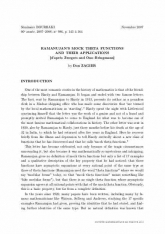Exposé Bourbaki 986 : Les « mock theta functions » de Ramanujan
Exposé Bourbaki 986 : Ramanujan's mock theta functions and their applications

- Consulter un extrait
- Année : 2009
- Tome : 326
- Format : Électronique
- Langue de l'ouvrage :
Anglais - Class. Math. : 11F11, 11F37, 33D15, 05A15.
- Pages : 143-164
- DOI : 10.24033/ast.843
Dans une lettre célébrissime qu'il a envoyée à Hardy juste avant sa mort en 1920, Ramanujan a introduit une e de fonctions très intéressantes qu'il appelait les « mock theta functions » et dont il a donné 17 exemples, mais aucune définition précise. Ramanujan entendait par « theta function » ce qu'on appelle aujourd'hui une « forme modulaire » et par « mock » quelque chose comme « fausse » ou « fantaisiste », et effectivement ses 17 fonctions avaient visiblement des propriétés analogues à celles des formes modulaires usuelles, sans toutefois appartenir à une e connue. Le mystère a été résolu en 2002 dans la thèse doctorale de Sander Zwegers (Utrecht), qui a démontré, par trois méthodes différentes, que ces fonctions pouvaient être complétées en y rajoutant des fonctions d'une forme explicite et très simple pour donner des formes modulaires non holomorphes. Sa théorie a trouvé par la suite plusieurs applications, notamment dans les travaux d'Ono–Bringmann, qui s'en sont servis pour démontrer des résultats conjecturés ou nouveaux concernant les propriétés des partitions et d'autres coefficients de séries $q$-hypergéométriques.

